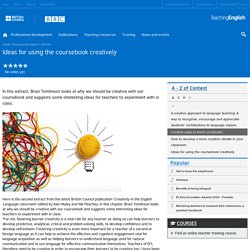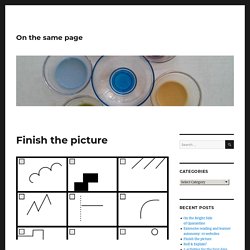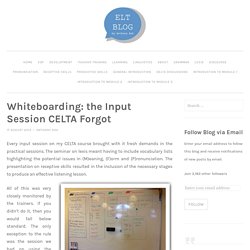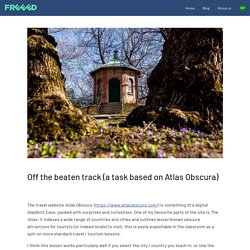

Great teaching toolkit: Evidence review. Teacher Support Pack - Global - 2. Cookies We use necessary cookies to make our site work.

We'd also like to set optional analytics cookies to help us improve it. We won't set optional cookies unless you enable them. Using this tool will set a cookie on your device to remember your preferences. For more detailed information about the cookies we use, see our . Cookie Information PageTiger View Policy cookie-preferences This cookie is used to remember your cookie preferences. Remembers your device between visits. These cookies allow you to temporarily view a document that is not yet published. These authentication cookies are required when viewing a restricted document. Used to remember your email address on pages that require authentication. PTIAccessibility* This cookie is used to remember if the viewer uses our accessible view interface. Teacher talk - Motivating students. Ideas for using the coursebook creatively. Here is the second extract from the latest British Council publication 'Creativity in the English Language classroom' edited by Alan Maley and Nik Peachey.

In this chapter, Brian Tomlinson looks at why we should be creative with our coursebook and suggests some interesting ideas for teachers to experiment with in class. "For me, fostering learner creativity is a vital role for any teacher as doing so can help learners to develop predictive, analytical, critical and problem-solving skills, to develop confidence and to develop self-esteem. Fostering creativity is even more important for a teacher of a second or foreign language as it can help to achieve the affective and cognitive engagement vital for language acquisition as well as helping learners to understand language used for natural communication and to use language for effective communication themselves.
Teachers of EFL therefore need to be creative in order to encourage their learners to be creative too. TeachingEnglish. Infographics. Finish the picture. How would you finish these pictures?

What if they were part of a story? Finish the picture.pdf This was one of those activities that surprise you every now and then: not only could the students working in pairs complete them in a short period of time, but the process involved questions and conversations about a wide variety of lexis as their creativity – and especially all the constraints – demanded more specific vocabulary. The students were also allowed to decide on the order of the pictures, which added some flexibility. If nothing else, the task does help students to create and plan their stories in a meticulous way. I also tried this activity with a higher group of students. Useful links for teacher training – Sandy Millin.
In August 2019 I started doing the NILE MA Trainer Development module and discovered there’s actually quite a lot of information out there to help teacher trainers, a lot of which had passed me by.

This post aims to collect what I’ve found. Please let me know if there’s anything you’d add or if any of the links are broken. Training for trainers International House offer a Teacher Trainer Certificate. It’s a 14-week online course, with 12 weeks of input and 2 weeks to finish your portfolio. NILE (Norwich Institute for Language Education) offer a Trainer Development course. IH ILC Brno run an annual trainers’ weekend.
Watch Your Language: Improving Communication with Non-Native Speakers - CornellCast. Describing Words - Find Adjectives to Describe Things. Work desk #ELTbookshelf □ #notrealllyafridaytweet □… BookReaderImages. Learn English online for free. Journals. Whiteboarding: the Input Session CELTA Forgot. Every input session on my CELTA course brought with it fresh demands in the practical sessions.

The seminar on lexis meant having to include vocabulary lists highlighting the potential issues in (M)eaning, (F)orm and (P)ronunciation. The presentation on receptive skills resulted in the inclusion of the necessary stages to produce an effective listening lesson. All of this was very closely monitored by the trainers. If you didn’t do it, then you would fall below standard. The only exception to the rule was the session we had on using the whiteboard, which went as far, ‘… if you want, you can include a whiteboard plan in your lesson plan.’ Take the board pens for instance. So, across the top of my classroom whiteboard I have the word ‘speaking’ written in black, ‘vocabulary’ in blue, ‘linguistic’ (grammar) in green and ‘pronunciation’ in red. Off the beaten track (a task based on Atlas Obscura) – Freeed.com. The travel website Atlas Obscura ( is something of a digital Aladdin’s Cave, packed with surprises and curiosities.

One of my favourite parts of the site is The Atlas: it indexes a wide range of countries and cities and outlines lesser known obscure attractions for tourists (or indeed locals) to visit; this is easily exploitable in the classroom as a spin on more standard travel / tourism lessons. I think this lesson works particularly well if you select the city / country you teach in, or one the students either know well or are particularly interested in. The following procedure is based on Budapest; however, the sequence of stages is generalisable, allowing you to adapt it to the city or country your students are interested in; just replace Budapest, and the links, with the city / country of your choice. Recommended Free ESL Resources (21.10.19)